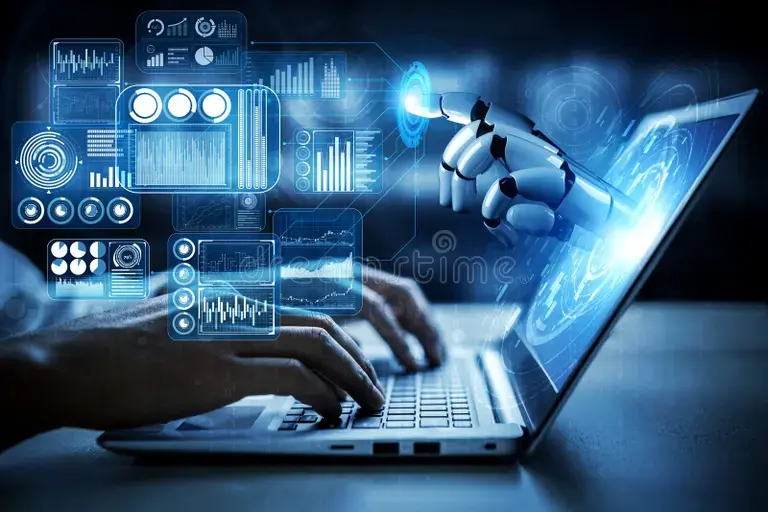The real risk of AI in marketing isn’t mass layoffs, it’s a collapse of trust. AI didn’t quietly creep into marketing; it stormed in. Suddenly, it’s drafting your social posts, optimizing ads, screening creators, handling support chats, and even whispering about the best time to publish.
The tools promise speed, scale, and efficiency, and they mostly deliver on these promises. But while the industry cheers the productivity boost, something more human and fragile is unravelling: trust. Once that goes, good luck clawing it back with your generative video or “perfect” AI persona.
This is the part of the AI story no one wants to talk about: not just how AI changes the work, but how it changes what works.
We’re Seeing a Crisis of Believability
Audiences are growing wary. Roughly two-thirds of consumers say they’re less likely to engage with content if they know an AI made it, especially if it feels too polished or “too perfect.”
A study found that an AI “virtual influencer” screwing up can hurt a brand more than a human influencer’s misstep. Because people blame the company that controls the AI, audiences might give a human the benefit of the doubt, but not a bot. People are inherently less trusting of content that isn’t human. And if that trust erodes, the whole marketing machine grinds to a halt. That’s the looming crisis no one is talking about.
Brands Keep Confusing Automation with Authenticity
In 2023, Levi’s announced it would test AI-generated models to “increase diversity” in its e-commerce images. It did not go over well. Critics blasted the move as a sign of peak laziness, essentially substituting real representation for algorithmic lip service. Why use an actual Black or brown model when you can just generate one? The backlash was fast and brutal: Levi’s hurried to clarify that these AI models were not a substitute for real diversity and inclusion efforts. In trying to automate representation, they torched some of the authenticity their brand had earned. A stark reminder that if you don’t have real diversity, you can’t fake it with an algorithm.
Meanwhile, social media platforms have been quietly blurring the line between genuine and artificial.
TikTok began flooding feeds with “shoppable” posts that creators never endorsed. Users call these changes dystopian, saying their feeds feel hijacked by ads. None of this is outright deception, but it’s not exactly authentic co-creation either. It all contributes to the creeping sense that the “real” in our feeds is being replaced with something manufactured.
We’re witnessing an erosion of human-centred brand experiences across the board.
This Isn’t About AI vs. Humans, It’s About What AI Should Never Do Alone
The answer isn’t to ban AI from marketing. The best brands are embracing AI with clear boundaries on what AI should and shouldn’t do. It’s not humans versus AI; it’s about using AI for what it’s great at, and never letting it replace the human elements that actually build trust and relationships.
AI can truly shine in many behind-the-scenes tasks. For example, it can:
- Scan thousands of posts or comments for red flags or trends in seconds.
- Generate a first-draft campaign report or batch of social media copy instantly.
- Streamline tedious workflows, such as legal approvals and compliance checks.
- Whip up creative ideas (drafting briefs or mood boards) in a flash.
These are tasks where scale and speed matter more than soul, perfect for automation.
However, AI is particularly weak at the human aspects. The work that requires nuance, empathy, and subjective judgment.
Consider the things you should never hand off to AI:
- Writing an influencer’s caption in their unique voice (an algorithm will flatten the personality).
- Guiding an online community conversation or handling a delicate customer complaint (that needs a human’s emotional intelligence).
- Crafting a sincere apology or navigating a PR crisis (a ChatGPT-written “sorry” will ring hollow).
- Building trust and loyalty. The slow, nuanced work of human connection that doesn’t scale through code.
You can’t program genuine empathy or cultural sensitivity, just like you can’t “optimize” authenticity without killing it. The parts of marketing that create real meaning and loyalty are often the ones that require a human touch.
Leading brands understand this balance. They use AI to automate the grunt work, allowing their human teams to focus on the personal work. They deploy AI as a shield, not a mask; automation supports their people, rather than replacing them.
Community Managers Know the Truth
Just ask any seasoned community manager or customer care rep: you can’t fake community. We’ve seen what happens when brands hand over their social engagement to bots or set-it-and-forget-it autoresponders. It never ends well.
One famous example is the Boston Marathon bombing, where several brands continued to auto-post lighthearted tweets and promotions because no one had paused the content calendar, resulting in automation turning into a PR disaster. Most specifically, Epicurious, which got called out socially.
The internet dragged those brands mercilessly (and rightfully so). It wasn’t a random fluke; this is what happens when you put your social on autopilot with no human oversight. Audiences are quick to call out canned, context-insensitive engagement.
Which is why it shouldn’t surprise anyone that 60% of consumers would prefer to wait in a queue to speak with a live agent rather than receive an instant response from a chatbot.
Even in an on-demand world, people would rather wait longer for an honest and thoughtful reply than receive a quick, generic bot response. They have more patience for a delay than for being BS’ed. And people can tell when there’s a human behind the screen; they value it. A soulless auto-reply, by contrast, immediately harms their perception of the brand.
The takeaway? There’s zero advantage to being fast if you’re faking it; it's better to be a bit slow but genuine than fast and phony. If your community replies are just AI-generated templates and emoji-filled “thanks,” people will smell it. And once they do, every interaction erodes trust instead of building it.
When Brands Get It Right
Here are a few cases where brands truly nailed the human element, moments of real influence that worked precisely because they were real.
Ocean Spray & Nathan Apodaca: When a TikTok video of a man longboarding with a bottle of Ocean Spray cranberry juice went viral, Ocean Spray’s response was brilliant, the CEO joined in with his tribute video and the company even gifted Apodaca a new truck full of juice, earning the brand a tidal wave of goodwill.
Duolingo’s TikTok Persona: A quirky social media manager lets the brand’s green owl mascot run wild in absurd skits (twerking, flirting with pop stars, etc.). It’s weird and hilarious, and it’s working, with over 4 million followers. The content rarely even mentions language learning; it’s just there to make people laugh.
Marriott’s Creator Residencies: Marriott flipped the influencer script with a “30 Stays, 300 Days” contest that sent real travellers around the world to document their adventures (instead of making ads). These winners weren’t making ads; they were sharing honest travel stories. The footage wasn’t glossy marketing; it was travel through real guests’ eyes, complete with unpredictable moments and personal touches. By footing the bill and letting people tell authentic stories, Marriott generated a trove of authentic content and reinforced that travel is about human experiences.
Ryanair on X (Twitter): Ryanair’s Twitter account is famously snarky and self-aware. When one passenger complained her plane seat didn’t have a window, Ryanair responded by tweeting a photo of a tiny wall bolt with the caption, “There’s your window.” That savage clapback got over 55 million views. By breaking every corporate PR rule, this irreverent approach made people trust the brand more. It feels like there’s a real, witty person behind the logo, and it’s endeared Ryanair to a new generation of flyers.
These moments resonated not despite being unpolished, but because of it.
The Creator Backlash Is Real
It’s not just audiences pushing back on artificiality; creators and influencers are drawing their lines in the sand. Authenticity is their livelihood, and they’re increasingly vocal that they won’t let brands dilute it with AI:
“If you’re just going to auto-generate everything, why do you even need me?”
“If you use AI to edit my content without my OK, I walk.”
Many creators are adding “no AI” clauses to their contracts with brands. They stipulate that no digital replicas of their likeness, no AI edits to their content without their approval, and no virtual avatars are to replace them. (In other words, creators feel they’re more than just a collection of traits to be cloned.)
“Smart brands may already be adding these clauses not because they’re anti-technology, but because they know transparency builds trust.” - Amy Choi (Trade School)
If a creator’s authenticity is compromised, so is their entire career. Influencers spend years building trust with their audience; if followers suspect a brand’s AI is puppeting their favourite creator, that bond shatters, and creators won’t stand for it.
There’s real resentment brewing. Brands that don’t understand this will quickly lose their top talent. A few high-profile influencers have even publicly “broken up” with brands that leaned too heavily on AI, stating it violated their trust and creative ethos. Because at the end of the day, no creator wants to be just a prop in an AI content assembly line.
The Bottom Line: This Is a Brand Trust Issue, Not Just a Tech Trend
This isn’t about chasing the following shiny tech toy; it’s about protecting brand trust and identity. People don’t compartmentalize your AI influencer campaign from your chatbot from your TikTok comments. It all blends into a single gut-level feeling about your brand.
So when your content starts to feel soulless or robotic, you don’t just lose a like. You lose credibility. People will begin to wonder:
- Did a human write that customer story?
- Was that CEO LinkedIn post genuine or AI-generated fluff?
- Is this “personalized reply” just a bot in disguise?
And once trust cracks, no amount of AI magic can patch it up. You can’t automate a redemption tour.
Look at how it’s playing out in the wild:
- Sports Illustrated came under fire for publishing AI-generated articles under fake bylines, sparking outrage over authenticity and eroding reader trust. (Futurism)
- TikTok creators are calling out AI products flooding their feeds with shoppable posts they didn’t endorse, complaining that it damages both their brand and their audience relationships.
- Artists and voice actors are publicly rejecting AI mimicry, refusing deals that involve brands cloning their voice or image without their consent.
Influence Scales With Trust.
AI should help you work smarter behind the scenes, not replace the human magic that builds relationships, sparks emotion, earns loyalty, and creates community.
Let AI handle the heavy lifting. Let humans make it matter. Because in an age of fake-everything, real people are your last true competitive advantage.
We know AI won’t build trust. People will. Discover how the most successful brands are balancing AI and authenticity in our latest white paper: Influencer Marketing at Scale: A New Model for the Social Era.

.png?width=96&height=96&name=Modern%20and%20Inviting%20Bariatric%20Banter%20Podcast%20Logo%20(2).png)


.png?width=300&height=300&name=Minimal%20Photocentric%20Productivity%20Blog%20Banner%20(3).png)
